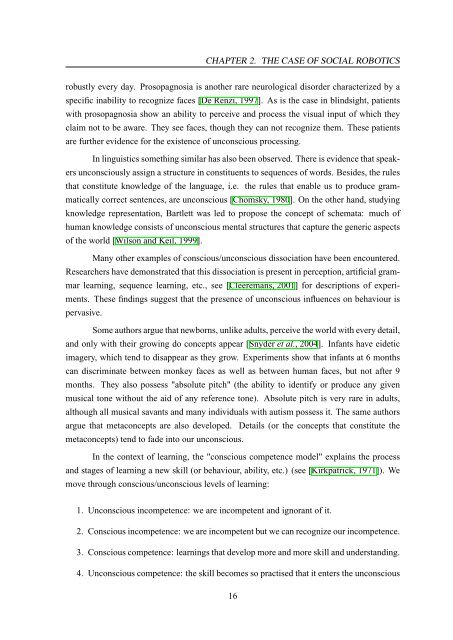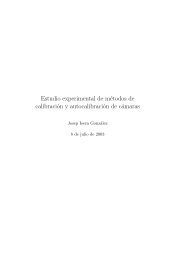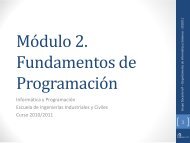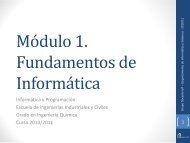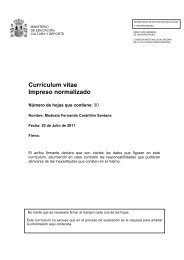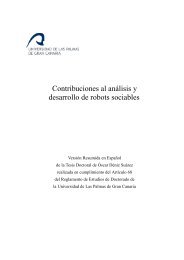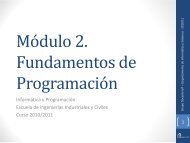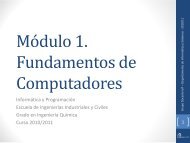PhD Document - Universidad de Las Palmas de Gran Canaria
PhD Document - Universidad de Las Palmas de Gran Canaria
PhD Document - Universidad de Las Palmas de Gran Canaria
You also want an ePaper? Increase the reach of your titles
YUMPU automatically turns print PDFs into web optimized ePapers that Google loves.
CHAPTER 2. THE CASE OF SOCIAL ROBOTICS<br />
robustly every day. Prosopagnosia is another rare neurological disor<strong>de</strong>r characterized by a<br />
specific inability to recognize faces [De Renzi, 1997]. As is the case in blindsight, patients<br />
with prosopagnosia show an ability to perceive and process the visual input of which they<br />
claim not to be aware. They see faces, though they can not recognize them. These patients<br />
are further evi<strong>de</strong>nce for the existence of unconscious processing.<br />
In linguistics something similar has also been observed. There is evi<strong>de</strong>nce that speak-<br />
ers unconsciously assign a structure in constituents to sequences of words. Besi<strong>de</strong>s, the rules<br />
that constitute knowledge of the language, i.e. the rules that enable us to produce gram-<br />
matically correct sentences, are unconscious [Chomsky, 1980]. On the other hand, studying<br />
knowledge representation, Bartlett was led to propose the concept of schemata: much of<br />
human knowledge consists of unconscious mental structures that capture the generic aspects<br />
of the world [Wilson and Keil, 1999].<br />
Many other examples of conscious/unconscious dissociation have been encountered.<br />
Researchers have <strong>de</strong>monstrated that this dissociation is present in perception, artificial gram-<br />
mar learning, sequence learning, etc., see [Cleeremans, 2001] for <strong>de</strong>scriptions of experi-<br />
ments. These findings suggest that the presence of unconscious influences on behaviour is<br />
pervasive.<br />
Some authors argue that newborns, unlike adults, perceive the world with every <strong>de</strong>tail,<br />
and only with their growing do concepts appear [Sny<strong>de</strong>r et al., 2004]. Infants have ei<strong>de</strong>tic<br />
imagery, which tend to disappear as they grow. Experiments show that infants at 6 months<br />
can discriminate between monkey faces as well as between human faces, but not after 9<br />
months. They also possess "absolute pitch" (the ability to i<strong>de</strong>ntify or produce any given<br />
musical tone without the aid of any reference tone). Absolute pitch is very rare in adults,<br />
although all musical savants and many individuals with autism possess it. The same authors<br />
argue that metaconcepts are also <strong>de</strong>veloped. Details (or the concepts that constitute the<br />
metaconcepts) tend to fa<strong>de</strong> into our unconscious.<br />
In the context of learning, the "conscious competence mo<strong>de</strong>l" explains the process<br />
and stages of learning a new skill (or behaviour, ability, etc.) (see [Kirkpatrick, 1971]). We<br />
move through conscious/unconscious levels of learning:<br />
1. Unconscious incompetence: we are incompetent and ignorant of it.<br />
2. Conscious incompetence: we are incompetent but we can recognize our incompetence.<br />
3. Conscious competence: learnings that <strong>de</strong>velop more and more skill and un<strong>de</strong>rstanding.<br />
4. Unconscious competence: the skill becomes so practised that it enters the unconscious<br />
16


